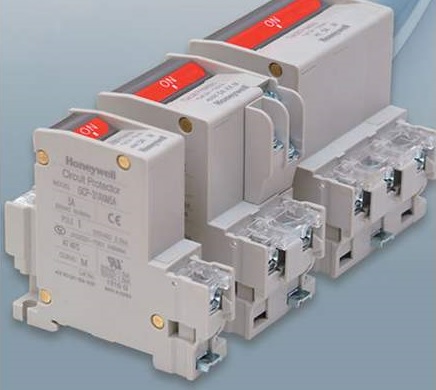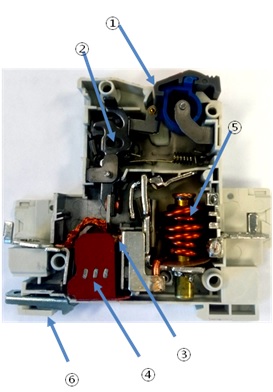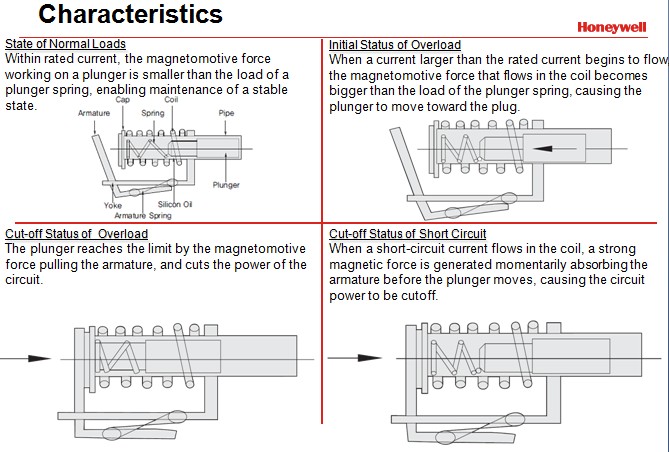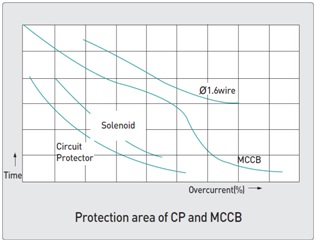What is the circuit protector?
Circuit protector, CP: circuit protector (not the well known network term couple oh ~). As the name implies, it is an electrical device used to protect circuits. So which part of the protection circuit or what function is protected? It is neither leakage protection nor overvoltage protection, nor is it surge protection.

Its shape is very close to what we know as air breaker. That's right; it does have a similar short-circuit protection function. Then you will definitely ask, I have air breaker; I have low voltage circuit breakers, why should I need circuit protector? Isn't it more than just one thing?
First, let us look at the design principle and action function of the circuit protector CP from the structural point of view.
As shown in the figure below, the CP is mainly composed of 1 handle, 2 switching mechanism, 3 contact,4 arc chamber, 5 electromagnetic hydraulic mechanism, and 6 shell. It looks like it has the same handle as the empty one for resetting. It has the same contact conduction circuit and has the disconnect function. Is there just one more arc chamber? wrong! Its key core component is the 5 electromagnetic hydraulic mechanisms. This is a closed copper shaft filled with silicone oil, with a core plunger in the middle and a copper wire around the ring. Obviously, you will come out smart. This is when you use current to generate magnetic force and pull the iron core up. When you reach the top, because it is close to the armature, it suddenly increases the suction force, causing the armature to move. The contacts are tripped and the short circuit is broken

However, because of the silicone oil, its function does not stop there. Silicone oil plays a buffering role, so CP has a delay function, which has the difference of low speed, medium speed and high speed disconnection. The following four illustrations show the state and action of the circuit protector in four different situations:

The function of state D is almost the same as that of the air breaker. At this time, because the short-circuit current is too large, the electromagnetic force is very large, and the resistance of the silicone oil and the spring can be neglected, and the armature is directly attracted and the contacts and the circuit are disconnected.
The different degrees of time of state B (medium and low speed selection) can allow normal inductive reactance such as normal starting of the motor in the loop.
While state C, because of long-term overcurrent, causes disconnection, protecting critical components or expensive circuits and boards from long-term high currents, temperature rise, component aging, and premature lifetime failure.
Let's summarize the difference between circuit protector CP and CB:
Circuit protectors and low-voltage circuit breakers CB: circuit breaker CB, they both have the general purpose of short-circuit protection. But the application, characteristics and protection forms are different.
Purpose: The air breaker/circuit breaker CB is designed to protect the line from short circuits, while the circuit protector CP protects individual electronic circuits or individual devices from short circuits, protects solenoids, or motors, computer boards, etc. Long-term high current (but less than short-circuit current) due to overload, etc., causes the device to overheat.
Type: Although the circuit breaker CB is intended to protect the line, the CP is used to protect the entire component or device and therefore requires various disconnect functions such as instantaneous, high speed, medium speed and low speed.
The figure below shows the difference between a typical CB breaker and a CP circuit protector.
| CB / air breaker | Circuit Protector /CP | |
| Objects | motors,power grid | Instruments,solenoid, Semiconductor circuit,electronic devices |
| Application | buildings,factory | Precision equipments, electronic devices |
| Sensitivity | low | high |
| Current | 3 ~ 4000A | 0.3 ~30A |
| Standard | EN 60898 | IEC 60934、GB 17701 |
Below figure below shows the difference between the micro-break MCCB and the circuit protector CP from the current and time axis:

For example, the principle of protection is detailed in the case:
Suppose you have a custom control system. PCBA has some expensive components such as industrial CPU to control the output equipment such as motor. The normal rated working current is 5A. The motor starts or the sensory loop occasionally has an instantaneous current of 10A. Short circuit protection is required above 16A.
If you choose a 16A open, then when the system current exceeds 16A, the air breaker is open and disconnected, which can control the system and the motor. However, if the system is overloaded, the current will remain at 10A for a long time, but it will not hit the cut-off value. At this time, the system may overheat, or the design life will be shortened, or eventually it will be down. Some systems have no predictive early diagnosis and protection, and once they are down, they will suffer a lot, especially for continuous large-scale operations such as petroleum and petrochemical. Iron and steel smelting and other industries, and restarting will also be time-consuming and laborious, and the loss of the intermediate machine is also very huge. This requires a weapon that protects against overheating and long-term overcurrent protection.
Then let's take a look, what if we choose a slow-breaking circuit protector CP? Suppose we choose a CP that is more than 10A and will be disconnected for more than 10 seconds. When the system starts normally or the motor starts, the instantaneous large current 10A is generated, and the CP will not operate. Because the time is very short, the whole system can be started normally, or it can allow the system to have an instantaneous surge, that is, the situation of state A. . If a short circuit occurs, the CP will open the entire loop protection system, that is, the state of state D, just like the open. If, for some reason, the system current increases or the motor current increases, such as 10A, it will remain on for a period of time (10 seconds). When it exceeds 10 seconds, the plunger overcomes the resistance of the silicone oil and rises. With the armature, the entire system will be disconnected. That is, state C, thus protecting the entire system from long-term heating or abnormal causes, the staff can conduct early inspections, preventive maintenance, improve system running time and life, reduce downtime and increase productivity. It can be seen that CP is more powerful than CB and has more comprehensive protection. It is suitable for occasions requiring precise protection and is more suitable for industry. When it comes with air breaker, it is cheaper and more suitable for civil buildings and general equipment protection.
For example, Honeywell GCP series circuit protectors, which are sold by Banning Sensing Technology Co., Ltd., are a combination of cost-effective switchgear and are the preferred solution for protecting expensive circuits. The wide range of installation methods and installation options gives you flexibility for your specific application. GCP series circuit protectors are ideal for applications that require small size, forced breaks, good repeatability, high reliability and long life. Users can choose from 0.1A to 40A in size, speed (I-short, H-speed, M-speed, L-low speed), as well as AC and DC options. For specific reference to the current rating and curve selection of the protected equipment, please contact Banning (Nanjing) Sensing Technology Co., Ltd., Tel: 400 7181 886.
Honeywell's manufacturing equipment and processes, high-quality materials, proven switch technology and design ensure stable performance and precise operation. GCP series circuit protectors can be widely used in semiconductor equipment, high-end machine tools, factory automation, instrument panels, industrial robots, food and beverage, electronics, and telecommunications base stations.
This article was written by Banning (Nanjing) Sensing Technology Co., Ltd.
Honeywell Product Selection Contact: 400 7181 886



